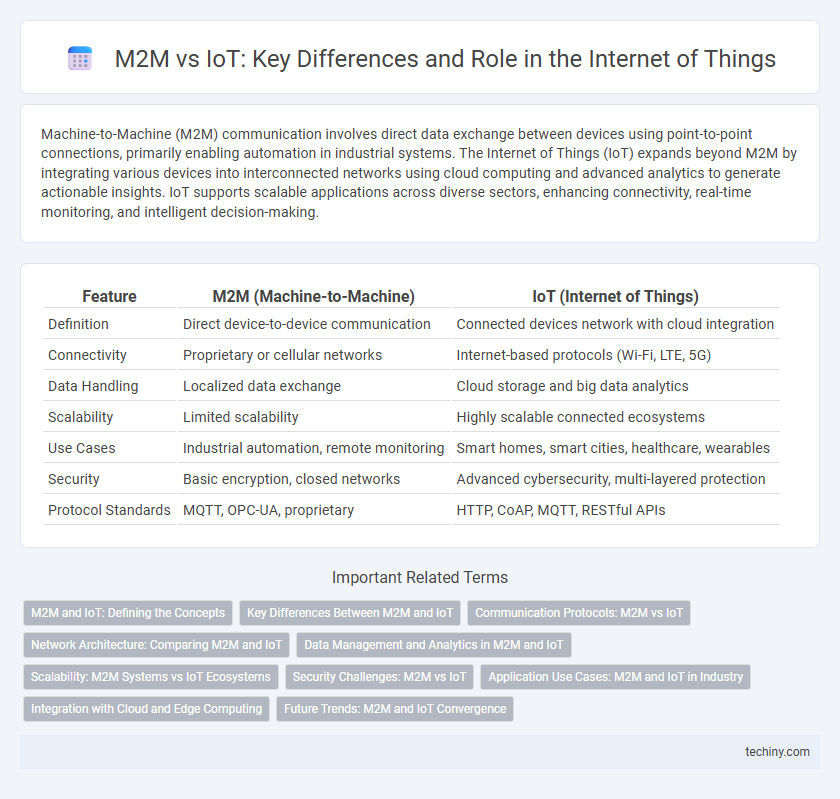Machine-to-Machine (M2M) communication involves direct data exchange between devices using point-to-point connections, primarily enabling automation in industrial systems. The Internet of Things (IoT) expands beyond M2M by integrating various devices into interconnected networks using cloud computing and advanced analytics to generate actionable insights. IoT supports scalable applications across diverse sectors, enhancing connectivity, real-time monitoring, and intelligent decision-making.
Table of Comparison
| Feature | M2M (Machine-to-Machine) | IoT (Internet of Things) |
|---|---|---|
| Definition | Direct device-to-device communication | Connected devices network with cloud integration |
| Connectivity | Proprietary or cellular networks | Internet-based protocols (Wi-Fi, LTE, 5G) |
| Data Handling | Localized data exchange | Cloud storage and big data analytics |
| Scalability | Limited scalability | Highly scalable connected ecosystems |
| Use Cases | Industrial automation, remote monitoring | Smart homes, smart cities, healthcare, wearables |
| Security | Basic encryption, closed networks | Advanced cybersecurity, multi-layered protection |
| Protocol Standards | MQTT, OPC-UA, proprietary | HTTP, CoAP, MQTT, RESTful APIs |
M2M and IoT: Defining the Concepts
Machine-to-Machine (M2M) communication refers to direct data exchange between devices using wired or wireless networks, primarily for specific industrial or operational tasks. The Internet of Things (IoT) encompasses M2M but extends connectivity to a broader range of devices with internet protocols, enabling real-time data analytics, cloud integration, and advanced automation. While M2M focuses on point-to-point device interactions, IoT integrates diverse systems and platforms to create scalable, intelligent networks for smart environments.
Key Differences Between M2M and IoT
M2M (Machine-to-Machine) focuses on direct communication between devices using wired or wireless networks for specific, predefined tasks, while IoT (Internet of Things) encompasses a broader ecosystem that includes devices, cloud computing, data analytics, and user interfaces to enable smarter, scalable applications. IoT integrates advanced technologies such as AI, big data, and edge computing, allowing dynamic data processing and real-time decision-making beyond the fixed point-to-point connections in M2M. Unlike M2M, IoT supports heterogeneous devices and protocols, fostering interoperability and enabling diverse use cases like smart cities, healthcare, and industrial automation.
Communication Protocols: M2M vs IoT
M2M communication primarily relies on point-to-point protocols such as MQTT and CoAP designed for direct device interactions within closed networks. IoT communication protocols extend beyond traditional M2M by integrating IP-based protocols like HTTP, MQTT, and LwM2M, enabling scalable, cloud-connected ecosystems with diverse device interoperability. The shift from proprietary M2M protocols to standardized, internet-friendly IoT protocols facilitates seamless data exchange, enhanced security, and real-time analytics across distributed environments.
Network Architecture: Comparing M2M and IoT
M2M (Machine-to-Machine) networks typically rely on direct device-to-device communication with limited integration capabilities, using point-to-point or star topologies primarily within closed systems. IoT (Internet of Things) networks feature multi-layered architectures that incorporate edge, fog, and cloud computing, enabling scalable, interoperable, and heterogeneous device connectivity across diverse environments. IoT's network architecture supports robust data processing and analytics, utilizing protocols like MQTT and CoAP, which enhance real-time communication beyond traditional M2M frameworks.
Data Management and Analytics in M2M and IoT
M2M primarily focuses on direct device-to-device communication for automated data exchange, often resulting in isolated data silos with limited analytics capabilities. IoT platforms integrate diverse data sources through cloud computing, enabling advanced data management, real-time analytics, and predictive insights across interconnected devices. Enhanced data processing in IoT facilitates scalable, actionable intelligence that drives smarter decision-making beyond traditional M2M systems.
Scalability: M2M Systems vs IoT Ecosystems
M2M systems typically involve direct device-to-device communication with limited scalability due to proprietary protocols and closed networks, restricting integration beyond specific applications. IoT ecosystems offer extensive scalability by leveraging standardized communication protocols, cloud platforms, and diverse device interoperability, enabling seamless expansion across industries and geographies. The open architecture of IoT supports dynamic device onboarding and data management, facilitating large-scale deployments that surpass traditional M2M limitations.
Security Challenges: M2M vs IoT
M2M (Machine-to-Machine) communication primarily involves direct device interactions with limited scalability, often relying on closed networks that provide a controlled security environment. IoT security challenges are more complex due to the massive scale, heterogeneity, and internet connectivity of devices, exposing systems to a wider range of cyber threats such as data breaches, unauthorized access, and privacy violations. Unlike M2M, IoT requires robust encryption, continuous security monitoring, and adaptive threat intelligence to effectively mitigate evolving vulnerabilities and safeguard interconnected ecosystems.
Application Use Cases: M2M and IoT in Industry
M2M technology primarily supports point-to-point communication for automated industrial processes, such as remote monitoring of machinery and asset tracking in manufacturing plants. IoT extends these capabilities by integrating cloud computing and advanced analytics, enabling predictive maintenance, real-time supply chain optimization, and smart factory automation. Industrial sectors leverage IoT for comprehensive data-driven decision-making, enhancing operational efficiency and reducing downtime beyond traditional M2M systems.
Integration with Cloud and Edge Computing
M2M (Machine-to-Machine) communication primarily handles direct device interactions without extensive cloud integration, whereas IoT systems leverage cloud and edge computing to enable scalable data processing and real-time analytics. IoT platforms integrate cloud services for centralized data storage and machine learning, while edge computing processes data locally to reduce latency and bandwidth consumption. This hybrid approach in IoT enhances system flexibility, supports complex application development, and improves response times compared to traditional M2M setups.
Future Trends: M2M and IoT Convergence
The convergence of M2M (Machine-to-Machine) and IoT (Internet of Things) is driving enhanced connectivity and data exchange across automated systems and smart devices. Future trends indicate increased integration of AI and edge computing, enabling real-time analytics and proactive decision-making in sectors such as manufacturing, healthcare, and transportation. This fusion optimizes operational efficiency and creates expansive ecosystems where interconnected machines and IoT-enabled devices collaborate seamlessly.
M2M vs IoT Infographic

 techiny.com
techiny.com